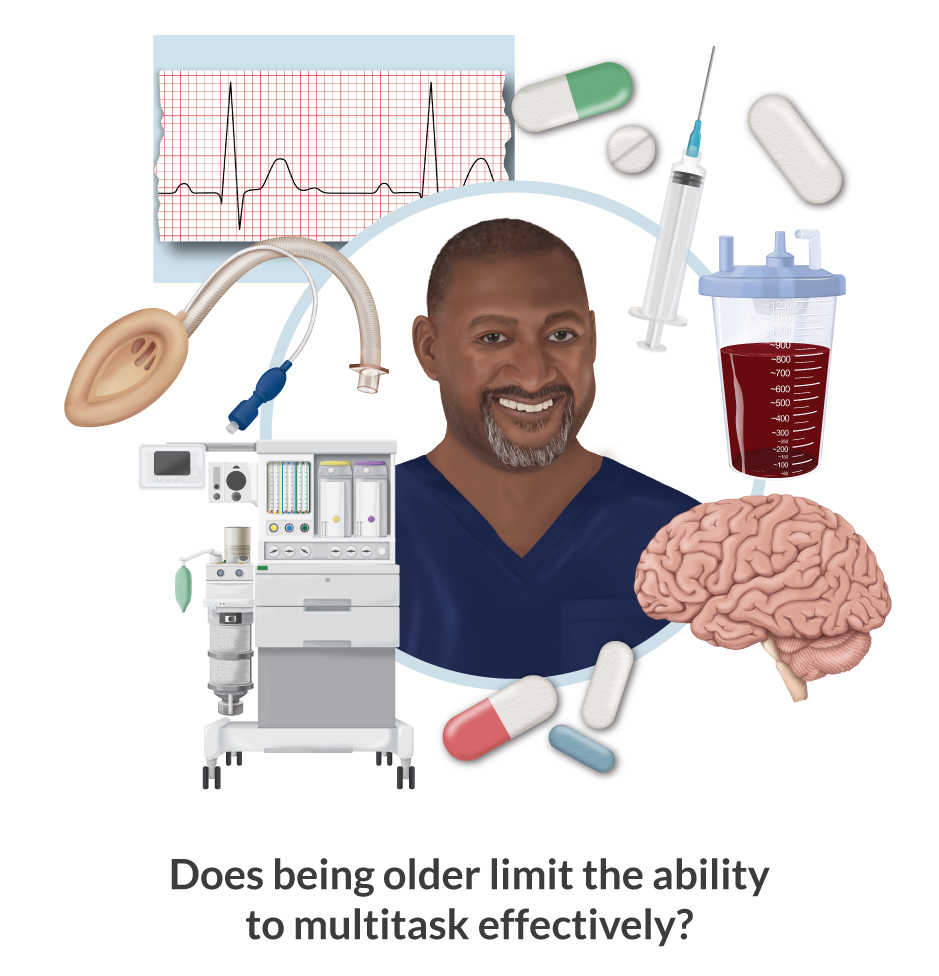In literary, musical, and cultural traditions, ‘Methuselah’ epitomizes great longevity, potency, durability, and sustained performance. There is even a tree called Methuselah, California’s Great Basin bristlecone pine, believed to be the longest-living tree on Earth at over 4,860 years!
We’ve chosen to use the “Methuselah of the OR” as an allegory for those CRNAs who may self-identify as timeless and ageless clinicians. Doing so begs the question: what should the CRNA retirement age be from direct patient care? But that prompts others as well. Is the question a relevant one? Is there any evidence that there is a concern? Can we look to other professions for guidance?
| Table of Contents
- Mandatory Retirement Age from One’s Profession
- What About the Anesthesia Provider?
- Is There a Hesitancy to Deal with Aging in the Clinical Setting?
- What the (Limited) Available Literature Suggests
- Final Note on the Aging CRNA
Mandatory retirement age from one’s profession: A growing trend
The FAA mandates pilots of commercial passenger airlines retire at age 65, although they may fly other non-passenger aircraft if training and health screenings are maintained. Recent efforts to extend the retirement age have yet to win approval in both the House and Senate.
A few other “mandated” retirement ages include:
- Air traffic controllers, age 56, with certain exceptions up to age 61.
- State Department Foreign Service employees, age 65, also with certain specific exceptions.
- Federal law enforcement officers, such as the FBI and National Park rangers, age 57.
- Many other nuanced retirement ages, for example, Minnesota court judges, age 70, and for Oregon’s judges, it’s age 75.
While we searched for high-quality studies that support or inform the above mandates, we noticed a remarkable absence of evidence in each case. Age limits seem guided primarily by factors arbitrary in nature or based on historical context that may no longer have merit.
Consider that those who establish U.S. federal and state laws, act as policy architects, and provide general governance, that is, members of the House and Senate, have no mandatory retirement age. This matter has generated considerable recent attention regarding the “advanced” age and, in some cases, infirmity of some legislative members.
And, of course, there is President Biden, 80 years old, running for a second term, and ostensibly one of a select few who are the most powerful people on Earth. We entrust him to make decisions affecting millions worldwide. In the next election, he may have a competitor on the Republican side, Donald Trump, who is currently 77 years old. There are no limitations on age and our presidency.
What about the aging anesthesia provider?
Anesthesiology is a profession that places considerable cognitive, task-performance, and physical demands on each of us. Is there, or should there be a ‘mandatory’ retirement age?

Let’s ask if there is even a problem, or does the profession take care of itself like professional sports teams do? Their athletes self-recognize it’s time to retire, or those paying their contracts no longer renew them based on degraded performance. Analytics can quantify performance in terms of hard evidence such as yards rushed, batting average, points scored per game, or some other metric.
When does a CRNA’s years of experience begin to falter in compensating for what may be an eroded capacity for the cognitive, skill-performance, and physical demands of our specialty? And that begs another question: how do we propose to determine ‘eroded capacity’ in those 3 domains?
CRNAs are not immune to the phenomena of an aging workforce. In fact, a study conducted in 2020 found almost 50% of nurse anesthetists were age 50 or older. These older providers can include clinicians who carry their careers into their 60s and 70s, bypassing those retirement ages enforced in other industries. With so many CRNAs approaching or surpassing average retirement ages, there are concerns about who will carry the torch for the profession. A 2019 survey by the American Association of Nurse Anesthetists found that 20% of the CRNA workforce was preparing to retire by 2025.

Is there a hesitancy to deal with retirement ages in the clinical setting?
The peer-reviewed literature is, with few exceptions, whispering or mute on the issue of the aging provider. This suggests to us one or more of the following:
- We don’t want to bring it up because it is uncomfortable.
- It is difficult, expensive, and intrusive to measure performance.
- It has practice implications for all of us; we don’t want to fuel medicolegal crises with arbitrary or potentially flawed guidelines.
- Ageism is real, and laws protect us from age-based discrimination.
- Concerns about job performance, credentialing, and recertification render this an ultra-high-stakes domain.
- If mandated age limitations emerge, might that invite scrutiny about emotional health, lifestyle, drug use, sleep habits, and comorbidities? It’s a slippery slope of personal invasiveness.
Our profession, like aviation, involves the risk of injury to its consumers. Shouldn’t we be concerned that the performance of CRNAs might eventually be degraded or imperiled by the aging process? Is there a risk management issue for the entities that employ or certify them? Does experience become a ‘two-edged sword’—while improving recognition of clinical cues, it may degrade reasoning speed?
What the (limited) available literature suggests
Providing anesthetic care to an older patient differs from caring for a younger one. There are different physiological and pharmacological concerns. While these differences are vital considerations in our patients, how do they play out in the younger vs older practitioner? And what exactly constitutes an “older” practitioner?
A recent study in JAMA Surgery noted the following regarding practicing physicians:
- Well over 20% are 65 or older.
- Research reveals that between 40 and 75 years, mean cognitive ability decreases by over 20%, but there is great variability.
- With age, formal cognitive and anonymous peer evaluations would benefit providers and patients.
- Professional organizations should develop age-related initiatives before regulators impose draconian policies and procedures.
A 2020 study in Geriatric Nursing authored by CRNAs, titled “Considerations for an aging CRNA workforce,” revealed:
- Our workforce is aging, with half of it aged 50 or greater.
- Management and educators have the highest mean age.
- For CRNAs working part-time, the mean age was 56.2 years.
- 1 out of every 7 CRNAs (13.4%) responding to a mailed survey was greater than age 65.
- Practice owners and independent contractors tend to be the oldest.
- Older workers face special challenges that can decrease productivity and job satisfaction.
- Older CRNAs experience common injuries resulting from repetitive motion, falls, needlestick injuries, fatigue, and emotional health illness more so than their younger colleagues.
- Creating a healthy and supportive work environment to improve the quality of work life and staff retention is encouraged.
- Providing scheduling flexibility, part-time work, and phased retirement are urged.
- Evidence suggests 12-hour workdays negatively impact providers’ health, yet older CRNAs commonly work these shifts.
And a final paper from the Canadian Journal of Anaesthesia, involving physician anesthesiologists has relevance. The authors point out:
- Those older than 65 were disproportionately likely to have litigation claims against them compared to younger coworkers.
- The older clinician takes up to twice as long to process information as they progress from their 20s to their 70s.
- Manual dexterity and visual and auditory acuity gradually degrade over the providers’ 20s to their 70s.
- Anesthesiologists work independently, making provider monitoring challenging; decisions about competence and retirement usually rely on self-assessment.
- Current evidence suggests the need for a proactive approach with an annual review and competency using simulated case events.
Final note on the aging CRNA

Plato wrote that old age “gives rise to all manners of forgetfulness as well as stupidity,” thus, older people should not be in important or leadership roles. You may recall Shakespeare’s King Learand how he was portrayed as an old, weakened man who constantly struggled with his failing cognition. Hardly portraits of a Methuselah!
There is much to think about regarding older CRNAs and their clinical practice. Though the literature is scant, with anecdotes and opinions predominating, there are a few takeaways we should consider:
- Like investing, planning your career retirement is never too soon.
- We should be mindfully self-aware of our limits rather than have those pointed out to us by others.
- Look to those who’ve transitioned from practice to alternative careers or retirement successfully as models.
It is a hard-earned privilege to practice the art and science of anesthesiology. While being a Methuselah in the OR may not be the goal for all, currently, no national age standards limit those who so aspire.
As CRNAs ourselves, we understand the challenge of fitting CRNA continuing education credits into your busy schedule. When you’re ready, we’re here to help.







